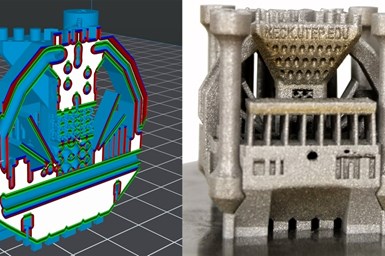Dyndrite Joins NMIS to Advance 3D Metal Manufacturing Research
Dyndrite has joined NMIS to help develop build recipes and shareable knowledge in materials process development across all major laser powder bed fusion OEM file formats.
Share
Read Next

Photo Credit: Dyndrite
Dyndrite has joined the National Manufacturing Institute Scotland (NMIS) to further research on 3D metal printer manufacturing. NMIS membership provides access to world-leading expertise, technical capability and opportunities to innovate together on the global stage.
NMIS plans to use Dyndrite in developing build recipes and shareable knowledge in materials process development across all major laser powder bed fusion (LPBF) OEM file formats. Dyndrite is the provider of a GPU-accelerated computation engine used to create next-generation digital manufacturing hardware and software.
The company will collaborate with researchers from the NMIS Digital Factory which is focused on developing LPBF process materials knowledge across multiple industries. The group will work on a variety of R&D projects, from assessing fatigue strength and corrosion resistance for biomedical applications, to finding the best materials properties for parts used within the energy sector.
NMIS members include Infor, Baker Hughes, Fanuc, ATS Global, Sandvik, Skyreal, Hybrid Manufacturing Technologies, Beckhoff, Nikken and Renishaw. Dyndrite joins this fast-growing roster of innovators looking to collaborate on complex additive manufacturing (AM) problems, particularly around expanding available materials and production automation.
“We are delighted to join forces with NMIS and members to develop AM metals materials and explore production automation of LPBF using repeatable build recipes,” says Stephen Anderson, Dyndrite’s head of strategic relationships. “By removing variation in the print process, we showcase how additive manufacturing scales to allow users to make more parts with greater consistency at a lower price. This is the key to unlocking new markets in 3D metal printing. This effort will drive metal AM into a mainstream production process and enable simpler traceability from powder to part.”
Dyndrite’s first end-user AM application is the Dyndrite Materials and Process Development for LPBF. This GPU-based 3D application (designed for engineers and scientists) simplifies and brings automation to the development of metal alloys and parts for laser-based 3D metal printing. It takes maximum advantage of Dyndrite’s Accelerated Computation Engine (ACE), including the ability to query 3D geometry in order to detect and optimize for difficult to print features such as domes, cantilevers and thin walls.
Dyndrite’s LPBF application increases print throughput, speeds development and lowers part costs. Users can also create and share build recipes (Python) that provide all the information required to recreate a build and drive the manufacturing process. Dyndrite’s LPBF application outputs to leading 3D metal printers, including Aconity3D, EOS, Renishaw, SLM and others.
“We’re excited to welcome Dyndrite as our newest NMIS member, where they will be working with our additive team,” says Stephen Fitzpatrick, NMIS Digital Factory director. “Dyndrite is a leading provider of 3D software for engineering and manufacturing applications. Our deployment will immediately help develop and grow our AM materials capabilities. Over the next year, we aim to collaborate on research projects that showcase novel additive use cases within process qualification and calibration and automated production lines. We look forward to getting started.”
- Learn about another Dyndrite collaboration, this time with MIMO Technik and Astro on machine, material qualification for 3D metal printing. The companies are collaborating on the development of the Mastro process in order to streamline and automate a closed-loop source for additive production and qualification.
- Read about Dyndrite joining ASTM to provide AM reference data. The collaborative effort aims to create shareable reference datasets that drive consistency across the industry, accelerating qualification and adoption of metal additive manufacturing.
Related Content
At General Atomics, Do Unmanned Aerial Systems Reveal the Future of Aircraft Manufacturing?
The maker of the Predator and SkyGuardian remote aircraft can implement additive manufacturing more rapidly and widely than the makers of other types of planes. The role of 3D printing in current and future UAS components hints at how far AM can go to save cost and time in aircraft production and design.
Read MoreTo Grow Additive Manufacturing Adoption, HP Is Aiming for the C-Suite
3D printing has been largely the purview of service bureaus and technical specialists but HP sees a future where it is increasingly the concern of OEM executives — and the company is taking steps to reach them.
Read MoreFaster Iteration, Flexible Production: How This Inflation System OEM Wins With 3D Printing
Haltec Corp., a manufacturer of tire valves and inflation systems, finds utility in 3D printing for rapid prototyping and production of components for its modular and customizable products.
Read MoreRead Next
4 Ways the Education and Training Challenge Is Different for Additive Manufacturing
The advance of additive manufacturing means we need more professionals educated in AM technology.
Read More3D Printing Brings Sustainability, Accessibility to Glass Manufacturing
Australian startup Maple Glass Printing has developed a process for extruding glass into artwork, lab implements and architectural elements. Along the way, the company has also found more efficient ways of recycling this material.
Read MoreAt General Atomics, Do Unmanned Aerial Systems Reveal the Future of Aircraft Manufacturing?
The maker of the Predator and SkyGuardian remote aircraft can implement additive manufacturing more rapidly and widely than the makers of other types of planes. The role of 3D printing in current and future UAS components hints at how far AM can go to save cost and time in aircraft production and design.
Read More





















